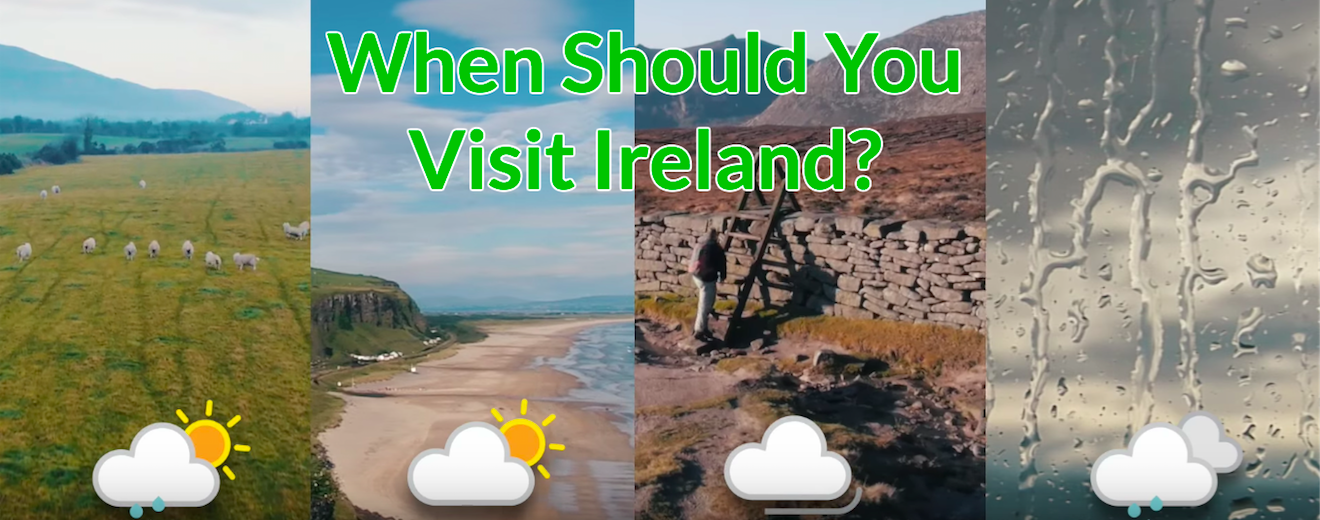The best time to visit Ireland is now.
Okay, that's the marketing slogan out of the way, now let's really get down to it. If you're planning a trip to Ireland, when is it really the best time to visit?
We've already taken you through the best time to book your trip and many of the considerations are the same. Chief among those being the eternal struggle for good quality, reasonably priced accommodation, particularly in Dublin. However, that's just half the battle when it comes down to selecting the dates of your trip. The eternal question remains the same - where is the happy medium between weather and prices?
Weather
Ireland's reputation as a wet and windy outcrop on the edge of Europe is not entirely without merit. However, despite sharing a latitude with parts of southern Alaska, the weather here isn't quite as big a consideration as you might think when it comes to figuring out the best time to visit.
The biggest concern for many visitors is rain and, granted, there is some justification for that. Strangely enough, Ireland's average yearly rainfall is considerably less than that of Florida and pretty much the entire southeast region of the US. So where does the reputation come from?
Put simply, if you're visiting Ireland at any time of the year, you're going to see rain. The west of the country is wetter than the east but, on average, Ireland experiences somewhere in the region of 200 days a year with more than 1mm of rain. In other words, don't forget to pack a light rain coat even if you're visiting in the height of summer. The old cliché of four seasons in one day is deceptively appropriate for much of the year.
While, rain may be the main consideration, we'd suggest taking a look at the temperatures instead. Ireland's climate is temperate, meaning that it never gets too hot or too cold. That's true, for the most part. In reality, the strong winds that pick up across the Atlantic mean that the wind chill can make sightseeing a bit uncomfortable in the middle of winter.
Average temperatures are at their lowest in January and February at 5°C with a gradual rise and fall peaking in July and August where temperatures are at an average of 16°C. Met Eireann always have up to date weather forecasts to help you out.
And if you're still in any doubt, Discover Ireland have put together this handy guide to everything that our weather will have in store for your visit.
Prices
As with most destinations, there are three distinct seasons to keep in mind when it comes to budgeting for your trip to Ireland. In truth, dividing the year into high, low and mid season is quite subjective and different individuals will have different definitions. With that in mind, here's how we generally categorise the seasons.

November to February is very much low season where prices are lower and so are temperatures. There's very little trouble in finding accommodation and prices are lower across the board. Some B&Bs close for the winter season but generally, there's never much trouble finding a place to stay within your budget.
March is still considered low season. However, things really start to pick up in the second half of the month with St. Patrick's Day seeing crowds flock to Ireland to get a taste of the revelry. From there, prices are still relatively low in April and May. June sees the beginning of the high season but it's between mid July and mid August that prices are at their highest across the board.
One final piece of advice that you need to consider is daylight hours and opening times of attractions. Daylight hours peak in June and fall to their lowest in December. As a result, the opening times of sites and attractions tend to follow suit. In winter, last admission to many sites is at 4:30 p.m. rising to 6:30 p.m. in the height of summer. Also, some attractions such as the landing tours to Skellig Michael are under a strict operating season with the UNESCO World Heritage site only accessible between May and September.
When Is The Best Time To Visit Ireland?
With all things taken into account, the best time to visit Ireland is in May or September. Prices are reasonable, accommodation is easier to find and the weather will never cause a problem. May in particular sees the most hours of sunlight on average, with prices still very reasonable.
Of course, those months are not feasible for everyone. If your options are curtailed by school holidays for example, it's best to visit Ireland in late June/early July. It's not quite the height of tourism season and car rental is slightly cheaper. You're also more likely to be able to find your first choice accommodation options.
Finally, if you're not too worried about the weather, November can be the perfect time to visit. It's very much the low season in terms of prices but, in general, it's milder and drier than December, January, February and even March.
The only thing left to answer is, what are you waiting for?


